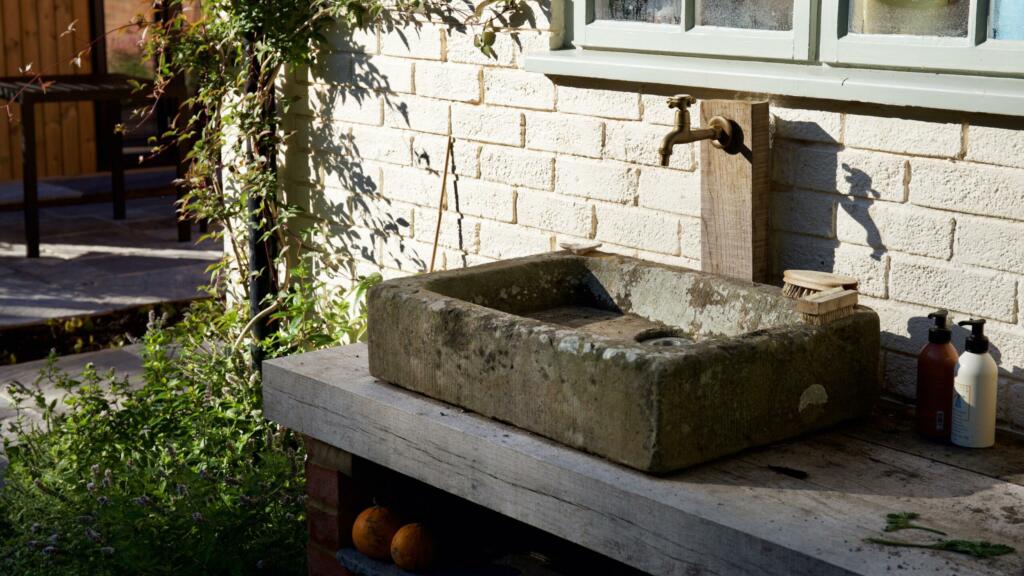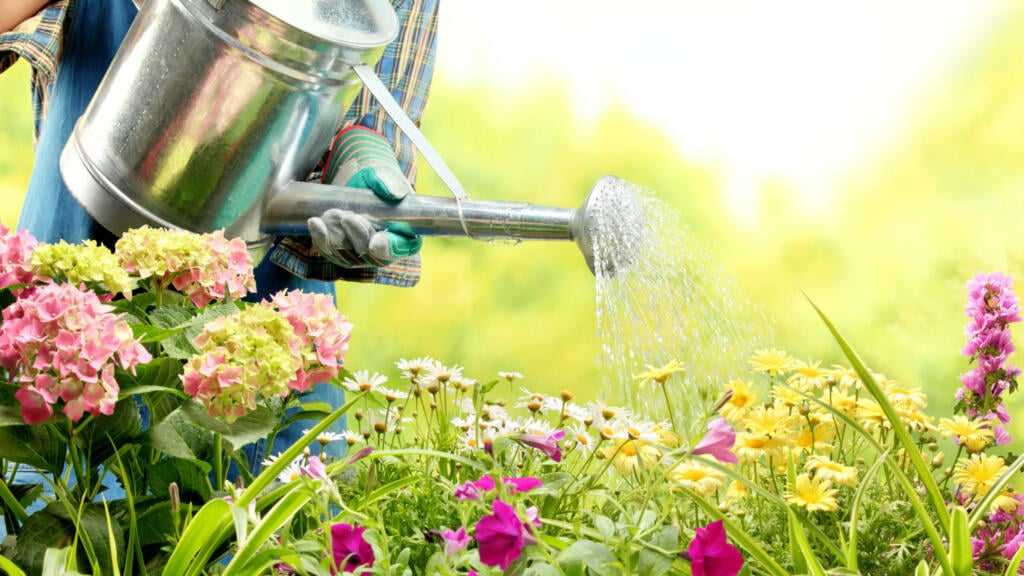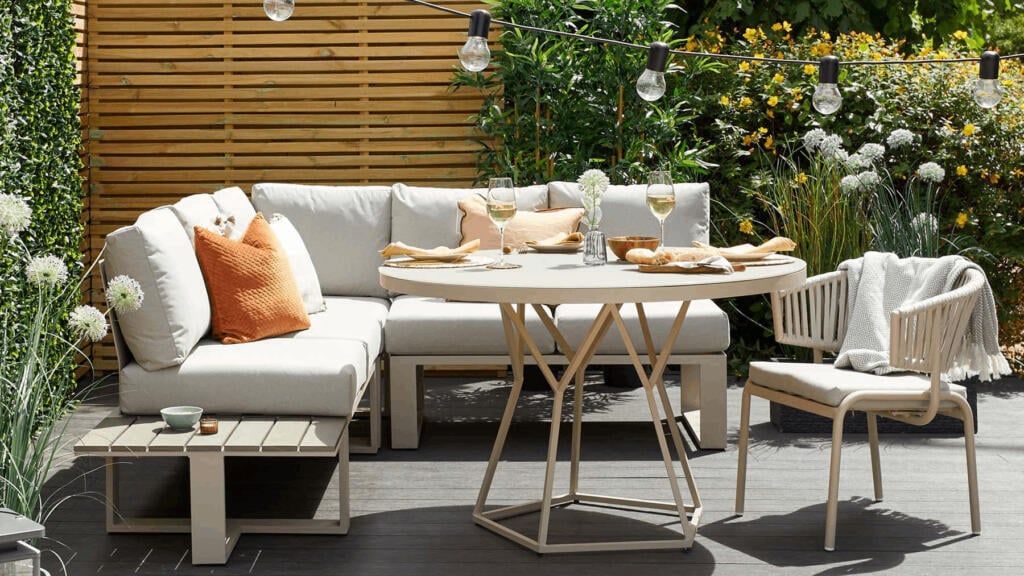
8 outdoor sink ideas to keep garden mess out of the kitchen
Rosanna Spence
We’ll show you ways to create more usable space.
However much we might want it to, nature doesn’t stick to straight lines and even surfaces. No garden is totally flat, and this can result in wonderfully textured, undulating outside spaces. But a steeply slanting garden can also leave you with several conundrums.
For example, where do you place garden seating so you don’t slide off the chairs? And how do you use awkward planting spots effectively? That’s where our sloping garden ideas will come in handy.
However much we might want it to, nature doesn’t stick to straight lines and even surfaces. No garden is totally flat, and this can result in wonderfully textured, undulating outside spaces. But a steeply slanting garden can also leave you with several conundrums.
For example, where do you place garden seating so you don’t slide off the chairs? And how do you use awkward planting spots effectively? That’s where our sloping garden ideas will come in handy.
 Credit: The Garden Company
Credit: The Garden CompanyWhether you want to construct raised beds filled with low-maintenance garden flowers, have dreamed of an outdoor kitchen, or want to improve accessibility, a garden with a tilt shouldn’t hold you back. We’ve consulted garden designers and experts for their best sloping garden ideas, which will help you transform unloved spaces into useful places to spend time in and enjoy.
 Credit: The Garden Company
Credit: The Garden CompanyPatios are excellent bridging areas between our interior living spaces and gardens. Often an extension of our lounges or dining rooms, they’re never more useful than when they’re simply providing level space.
This sloping garden idea, designed by James Scott and constructed by The Garden Company, meets a curved patio. It was important for the homeowner that the garden be visible from inside the house, and the deep border with expansive planting ensures that.
These deeply curved borders also allow what is quite a sizeable garden to still feel intimate, with smaller spaces cut into the slope and lined with wood.
 Credit: Karl Harrison Landscapes
Credit: Karl Harrison LandscapesThis series of mini terraced patios and lawns from Karl Harrison Landscapes breaks up the natural decline of the sloping garden. Each section will be fairly easy to mow and maintain (make sure you avoid making these grass-cutting mistakes, though). Plus, they are lined with smart planting areas, which you could fill with low-maintenance border plants to minimise the time you spend pruning.
There’s still enough room left for a dining area on the more levelled out section of the garden; this sloping garden idea has transformed every inch of ground into useful, usable space.
 Credit: Karl Harrison Landscapes
Credit: Karl Harrison LandscapesRather than simply having a decking area installed as you immediately enter the garden through the back door, why not introduce a deck as a sloping garden idea to break up an incline?
This example, installed by Karl Harrison Landscapes, does just that. This decking platform neatly cuts through the slope, creating a section of garden suitable for a seating area or barbecue. The edges of the deck will be softened when the planting scheme surrounding it grows, with ornamental grasses adding height and concealing the exposed corner.
Sloping garden ideas: what should you plant?
If you’re going to plant straight into steep, sloping ground rather than build a raised bed, Jacksons Nurseries suggests opting for low-growing groundcover plants that will help to maintain soil stability and minimise erosion. The company also says that it’s helpful to install self-sufficient, low maintenance plants, to minimise the amount of nurturing required, given the “challenging conditions”.
Here are Jacksons Nurseries recommendations:
Buy plants for sloping gardens and steep banks at Jacksons Nurseries.
 Credit: Marlene Lento Design Studio
Credit: Marlene Lento Design StudioThis sloping garden idea from Marlene Lento carves into the slope with a curved seating area. Lento says of her design: “The log roll followed a Japanese scheme and was used to retain the edge of beds and the edges of where the ground has been taken away to create the flat spaces and decks.
“The log roll then turned into a feature itself that enclosed the seating area, continuing the warm natural colour of the deck.”
The warm tones of the wood contrast against the cool colours of the firepit, as well as the seating, and the shingle covering the terrain to the rear. Leading with curves helps to cut through the slope of the garden like this in a soft way.
 Credit: Garden Trading
Credit: Garden TradingDepending on the location of your garden, you may be lucky enough to enjoy a gorgeous view from the top of it. If so, this sloping garden idea will help create the perfect spot to soak it up from.
By constructing a covered veranda or pergola at the very top of your sloping garden, you not only create a focal point of interest, but also an extra ‘room’ to relax in. This one, complete with seating from Garden Trading, offers incredible views across the surrounding landscape. Keeping the materials natural, including wood and rattan, means the colour scheme complements the elements around the structure.
 Credit: The Garden Company
Credit: The Garden CompanyThis sloping garden idea, designed by James Scott and constructed by The Garden Company, uses what could be a tricky, steep area to its advantage with rocks and planting.
“One key design challenge was to address steep slopes away from the house in the rear garden, which made for an awkward journey from terrace to grounds,” the company explains. “A rock bank combining sawn stone steps with rocks (handpicked by James from a Yorkshire quarry) was created to support the transition to a more naturalistic feel further away from the house, creating the impression that the garden had grown around existing rocks.”
The planting scheme helps to create a natural, cohesive journey from level terrace, up the steps, through the timber archway and finishing at the pergola.
 Credit: Garden Retreats
Credit: Garden RetreatsPrefer a lawn? Then slice through it with a pathway. Keeping it curved as it ascends a sloping garden will help reduce the incline. Though this sloping garden idea doesn’t include them, the path could be bordered by plants to soften the edges.
All the best paths lead to somewhere exciting, and a garden room is an ideal place to end your journey. This could be a home office or perhaps a hobby space. Either way, it’ll likely add value to your property (an average of 8.4% to the value of your home, according to The Property Centre).
 Credit: David Harber
Credit: David HarberIf you prefer art to planting, this sloping garden idea is for you. No matter how sprawling your outside space is, adding sculptures can emphasise any natural elevation.
Drawing the eye through and up the garden, sculptures can either reflect the shapes and textures of their natural surroundings, or contrast against them. These pieces, designed by David Harber, echo the simple shapes of the topiary shrubs and pruned trees. They highlight the gradient of the incline, which would otherwise be subtler due green lawn
 Credit: Shutterstock / Gardens by Design
Credit: Shutterstock / Gardens by DesignRockeries lend themselves well to a sloped garden. They can provide a wonderful habitat for plants and wildlife – and tend to look great no matter where you’re standing in the garden.
If you want to an add elements of a sensory garden to your rockery, then a waterfall complements this environment well. Introducing water to a garden can help make it a more relaxing place to be, and waterfalls, even small ones, are a good sloping garden idea, as there’s a natural path for them to flow down.
You can find more information about constructing a rockery and installing a waterfall by checking out these small garden rockery ideas.
Take care when planting on a steep slope
Gravity affects the way water travels through soils covering sloping ground. But there are some tricks to help reduce the adverse effect this can have on plants. The experts at the Royal Horticultural Society have shared guidance on its website that will help you plant more successfully on particularly steep slopes and banks in your garden:
 Credit: May & Watts Garden Design
Credit: May & Watts Garden DesignCalling all thespians! Here’s a sloping garden idea just for you. May & Watts Garden Design created this amphitheatre that transformed a steeply sloping walled garden into a place for performances and ceremonies.
OK, it’s unlikely the majority of people reading this are preparing their outside space for regular renditions of Shakespeare, but building lawn-covered terraces does have other uses too. The flat surfaces become much more practical, whether you want to build plant beds, pop a table and chairs up, or place some pots around. A scaled-down version of this majestic design could work well in a small garden with a steep incline.
 Credit: Shutterstock / Yolanta
Credit: Shutterstock / YolantaThey may be either side of a stairway, but the planted borders in this sloping garden idea certainly steal the limelight. Abundant planting and letting your flowers grow over onto paths gives gardens a natural and wild look.
The natural shapes of the stepping stones that lead you through the garden help to give this sloping garden soft edges. Though green is the dominant hue, the pops of colour from the flowers really break up the scheme and help to frame the stairway.
 Credit: Marlene Lento Design Studio
Credit: Marlene Lento Design StudioAs we know, installing decking is a useful way to create level ground for seating, dining, entertaining and container gardening. But you don’t have to stop at just one installation.
This duo of circular decks – designed by Marlene Lento – were cut into the slope of the garden and neatly cascade down. This offers people double the surface area of usable space. To finish the look, both decks are underlit, drawing attention to their placement on the slope.
If you love entertaining, and prefer glitz and glamour to naturalistic garden design, then adding lighting to your decking will elevate it. Plus, it helps to keep the edges of the decking more visible at night, which is useful on a gradient.
 Credit: Shutterstock / Lois GoBe
Credit: Shutterstock / Lois GoBeNot so keen on a lawn, but also don’t want to create plant beds that need lots of maintenance? Then a wildflower meadow is a great sloping garden idea. It provides lots of food for pollinating insects and birds, as well as covering plenty of ground with flowers. As always, check that the types of native wildflower seed you choose are suitable for your soil and area.
Though wildflower seed bombs – designed to be scattered on the soil’s surface – have become popular in recent years, some people have more success with other ways to plant wildflowers. Some gardeners plug their existing lawns with seedlings they have sown, though these flowers will then have to compete with existing weeds and turf. Bare ground that has been cleared of all weeds is usually the way to go – or you could buy rolls of turf that contain wildflower seeds already.

Written by Rosanna Spence she/her
Published: Updated:
Rosanna Spence has been a journalist for nearly 10 years, reporting on a huge array of topics – from microwaves to cocktails, sustainable buildings, the Caribbean islands and beyond. She’s interviewed chefs at the helm of Michelin-starred restaurants and chatted to countless CEOs about their businesses, as well as created travel guides for experienced travellers seeking life-changing adventures. Throughout her career, she has created content for Business Traveller, i-escape.com, Pub & Bar, BRITA, Dine Out and many more leading titles and brands.

Rosanna Spence

Debbie North

Camilla Sharman

Rosanna Spence